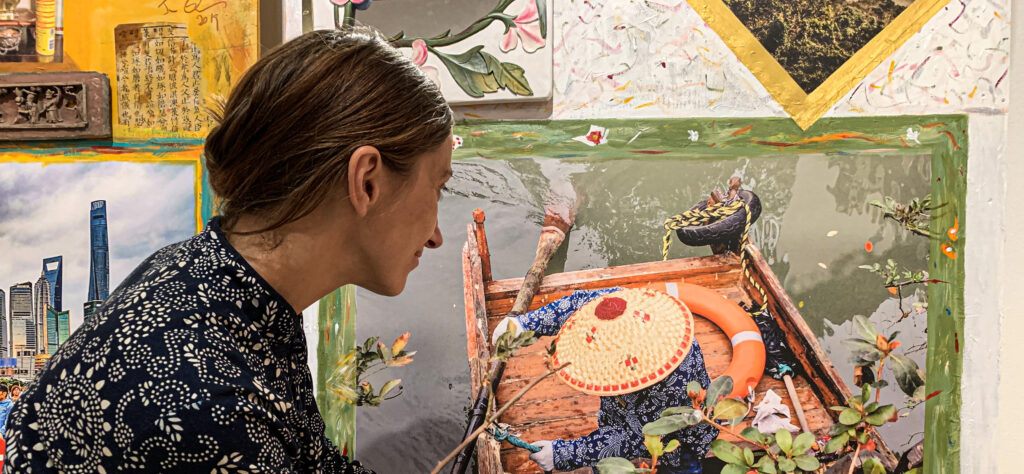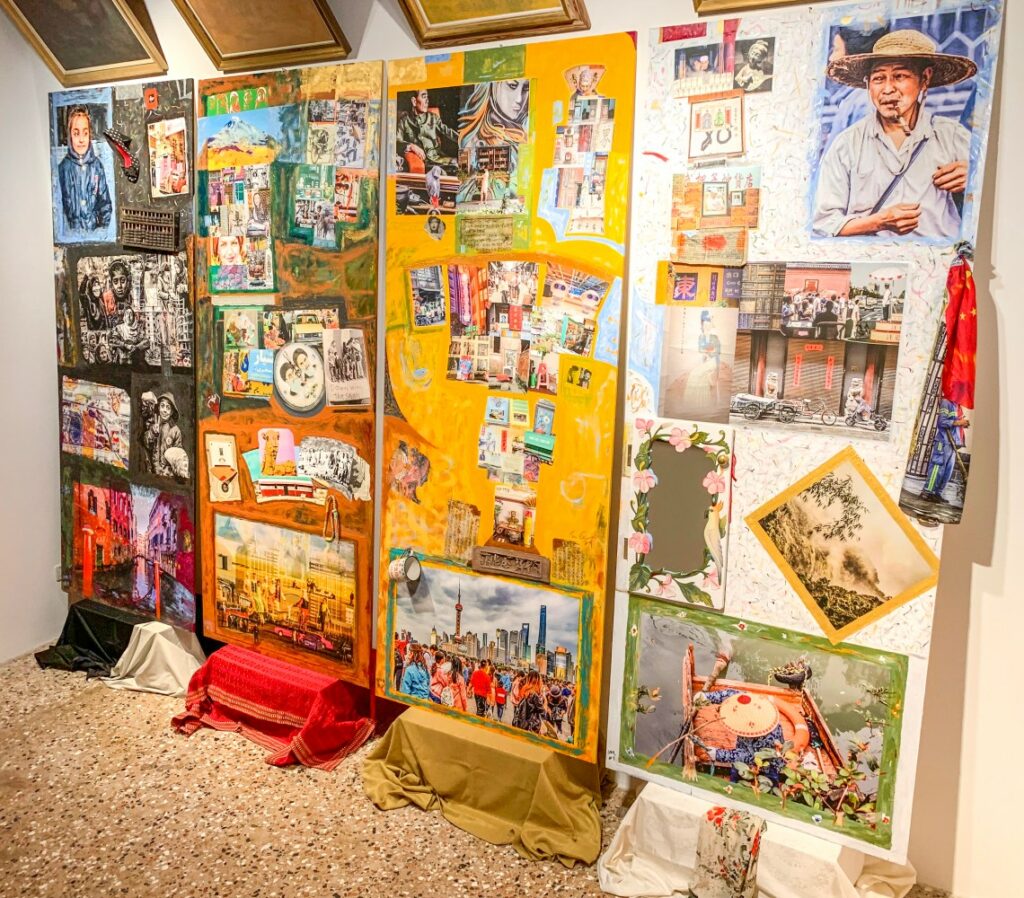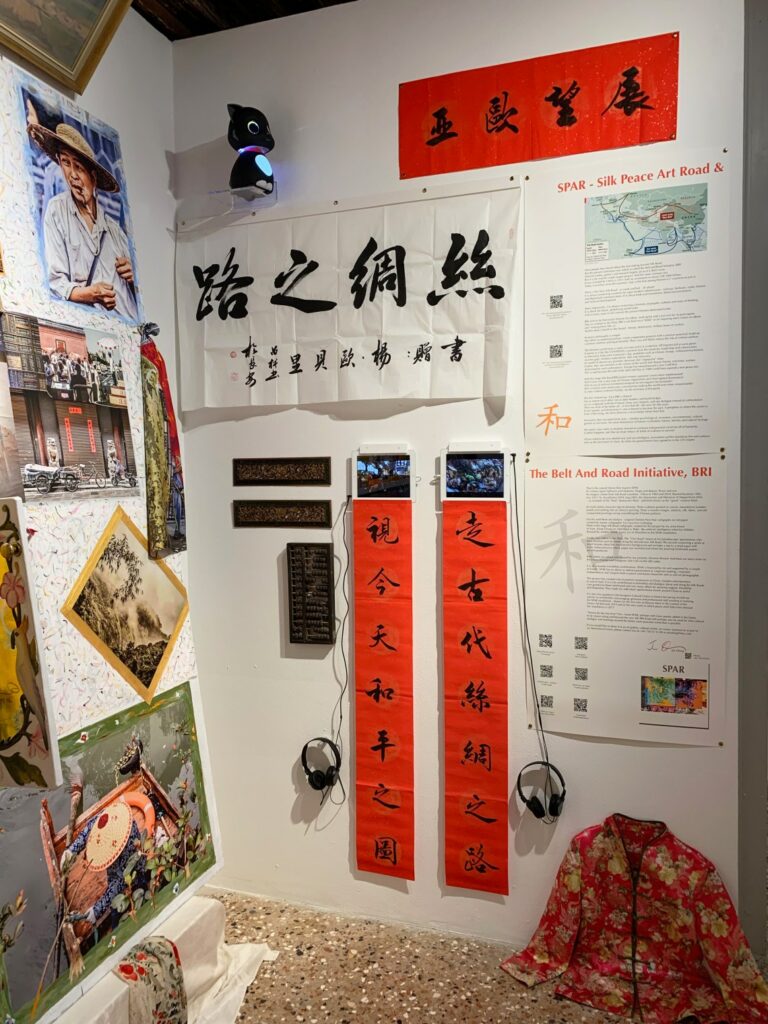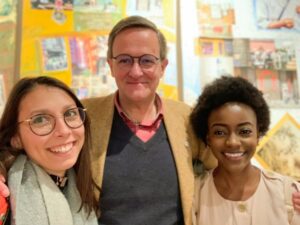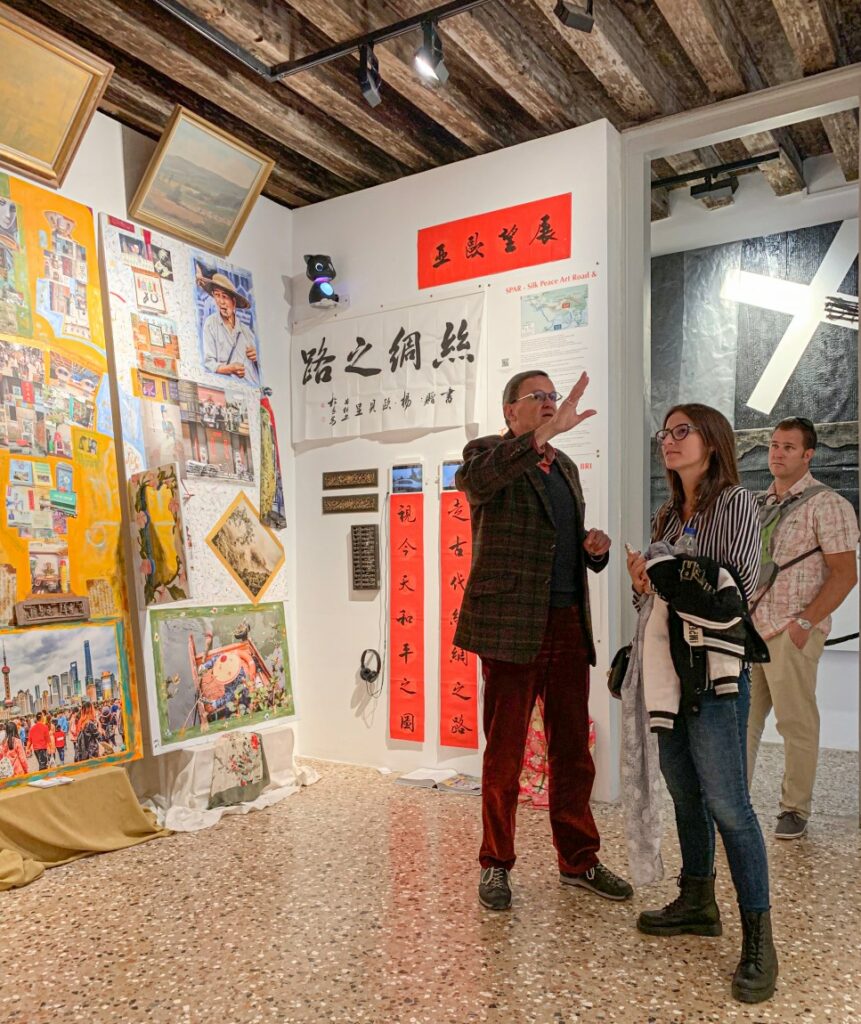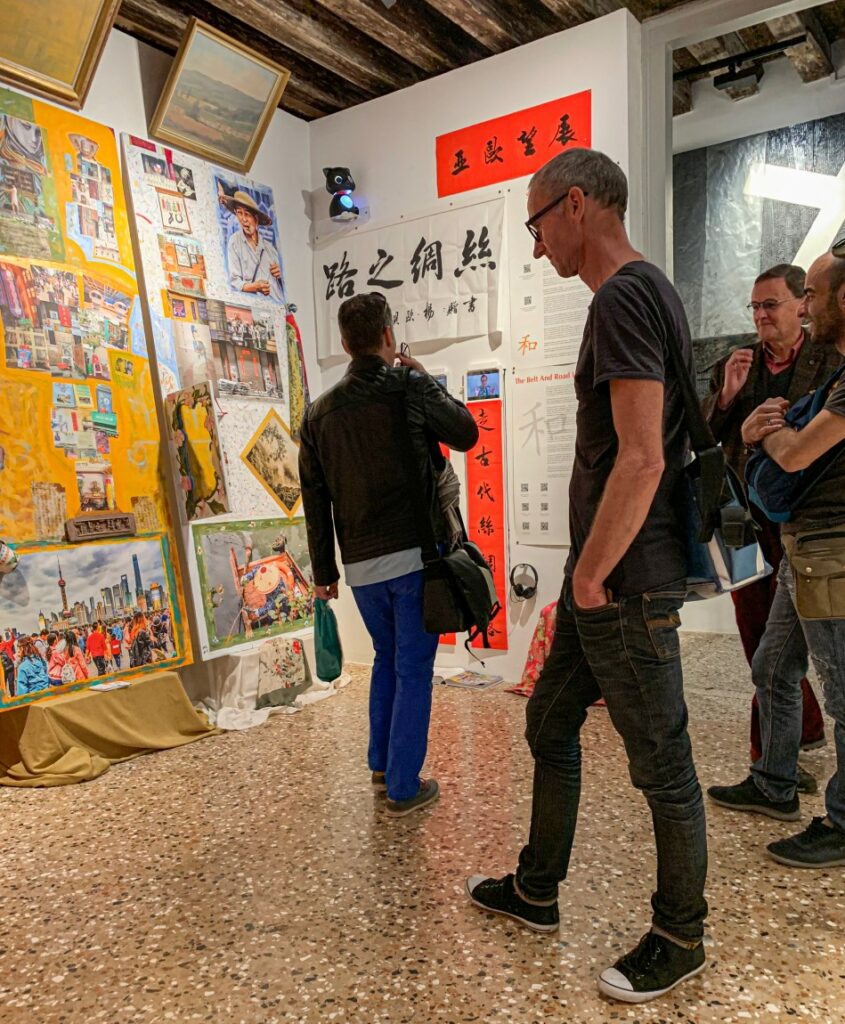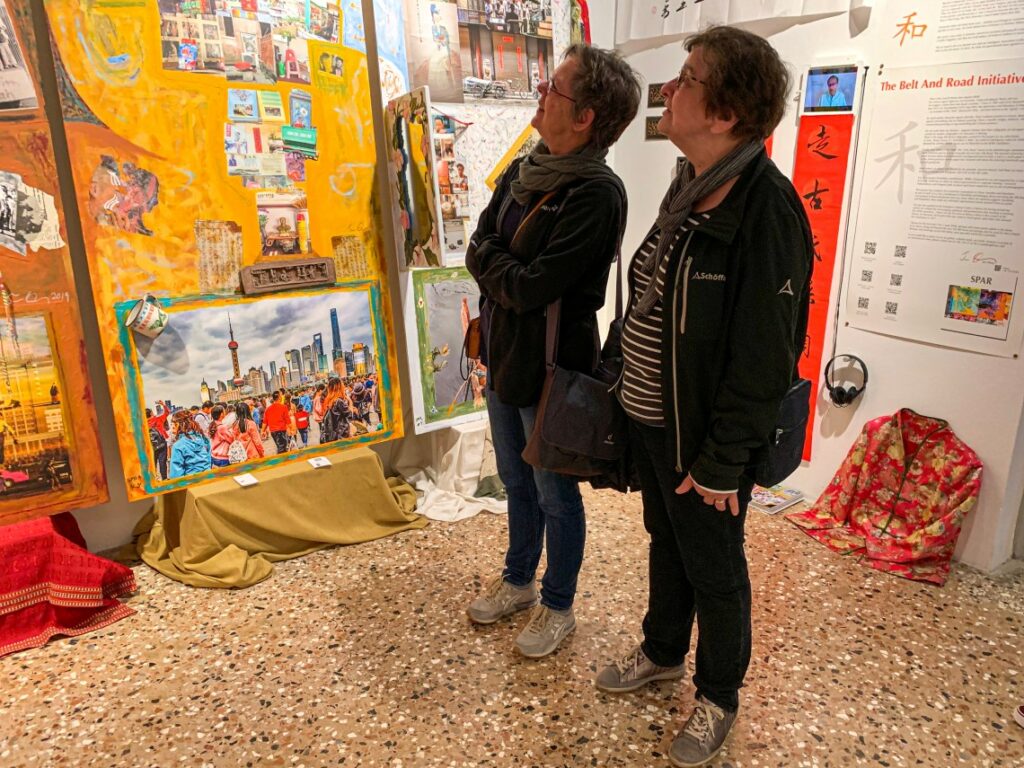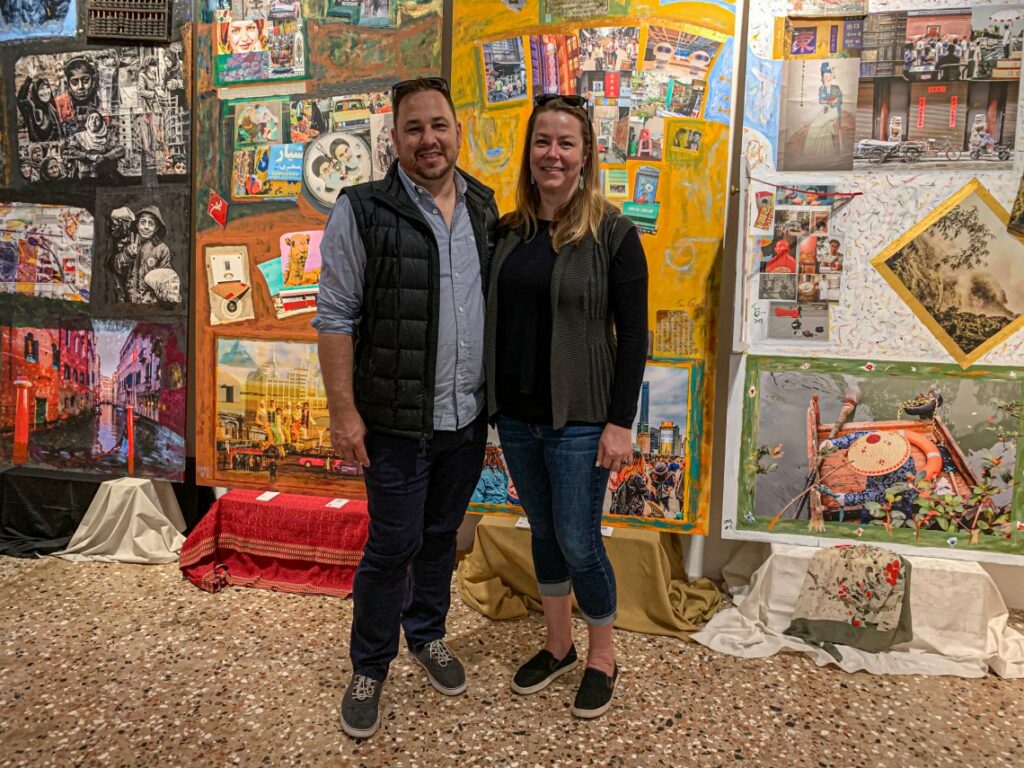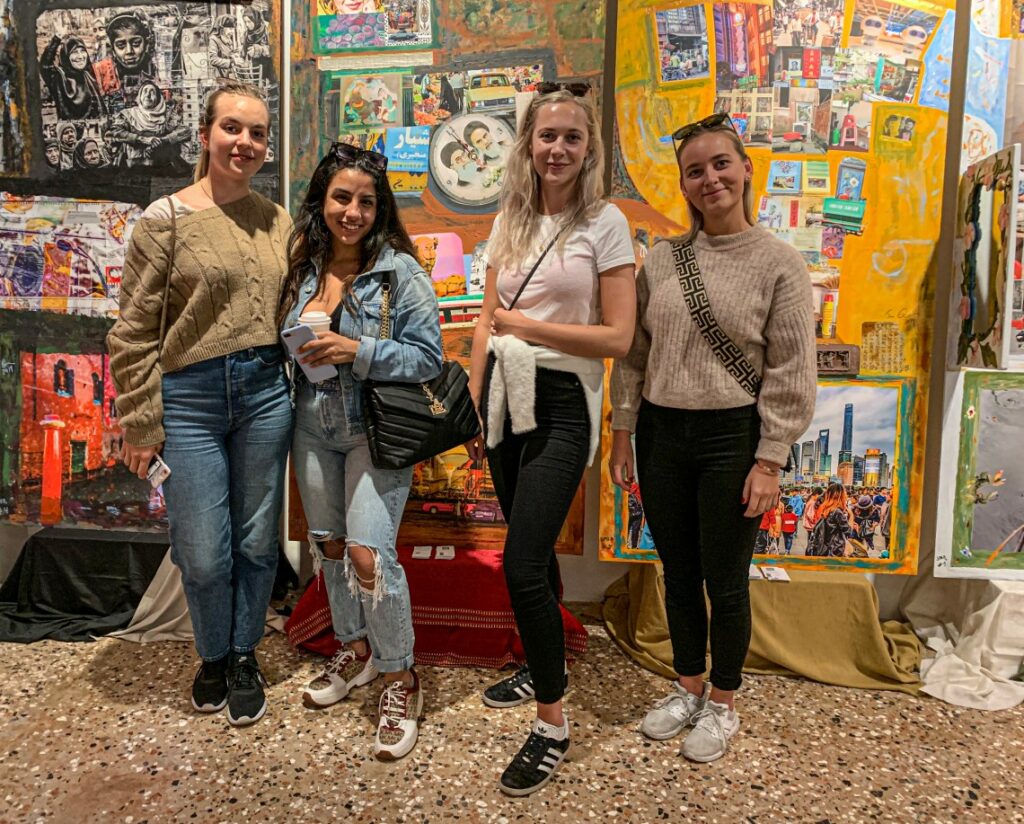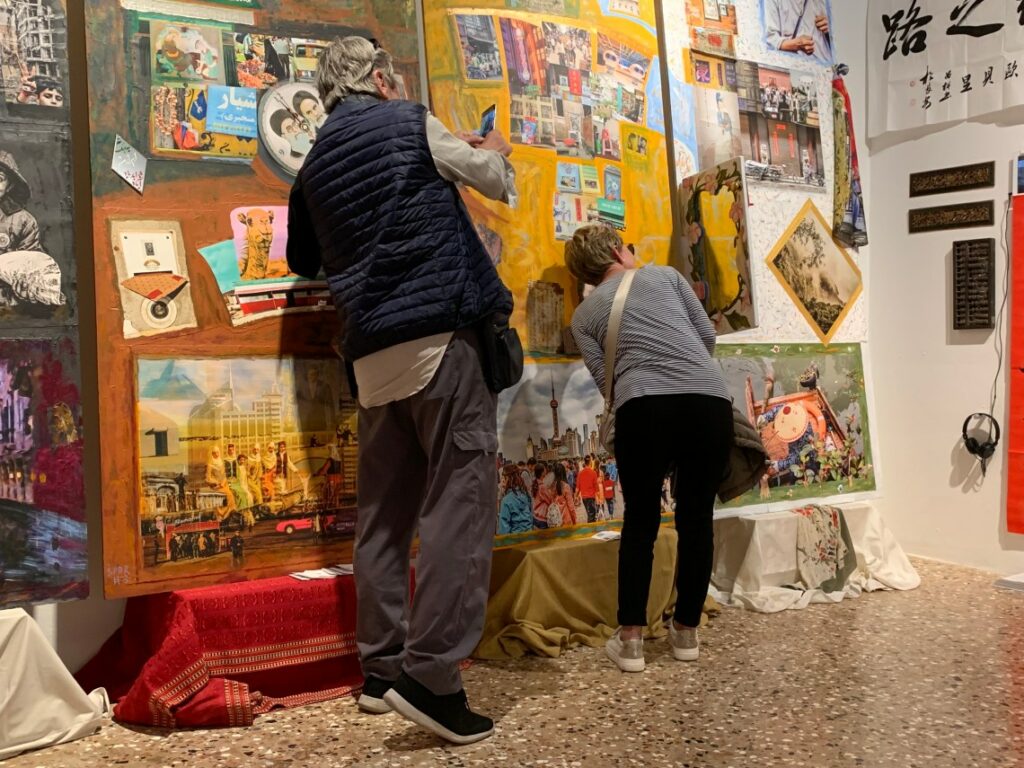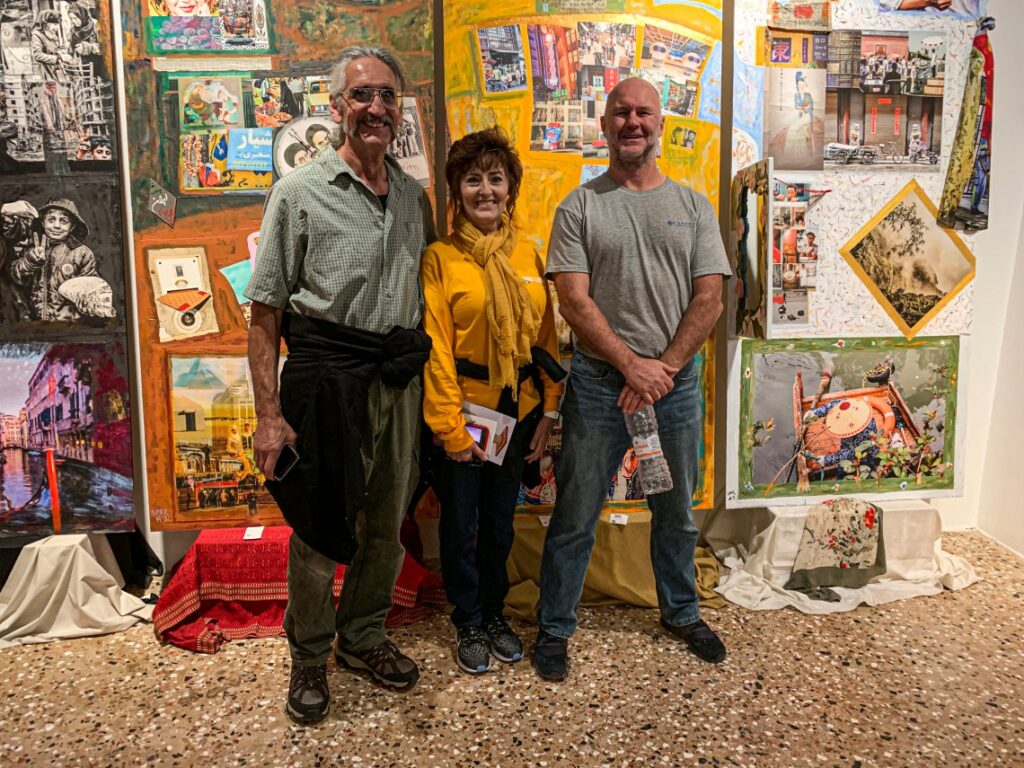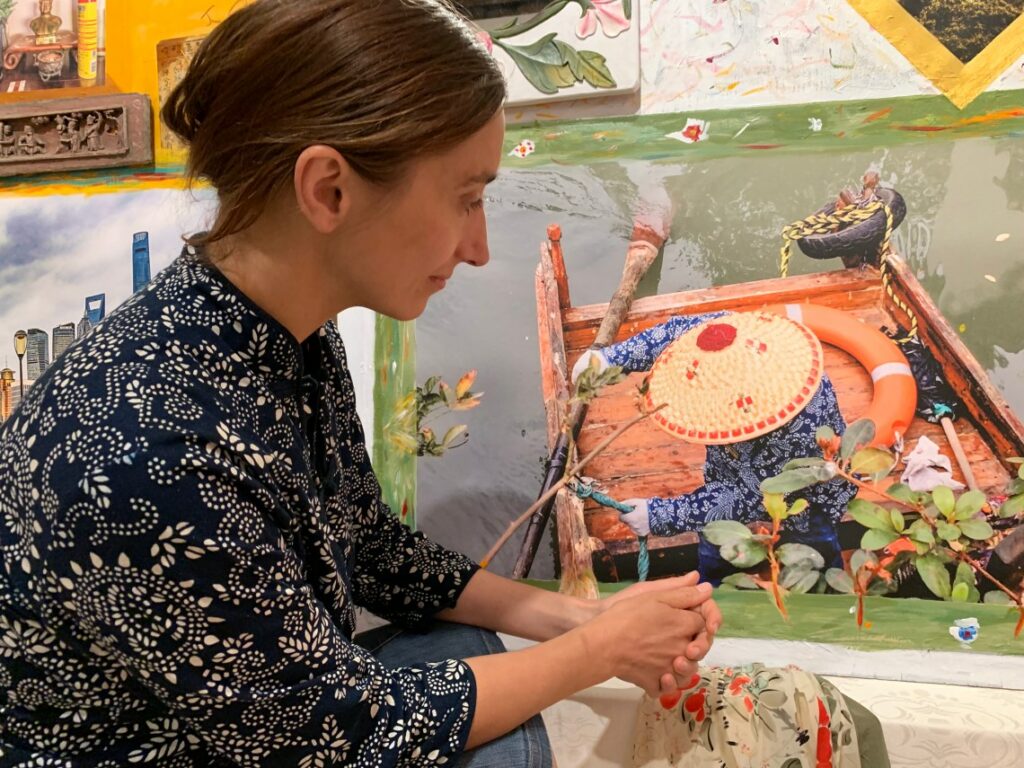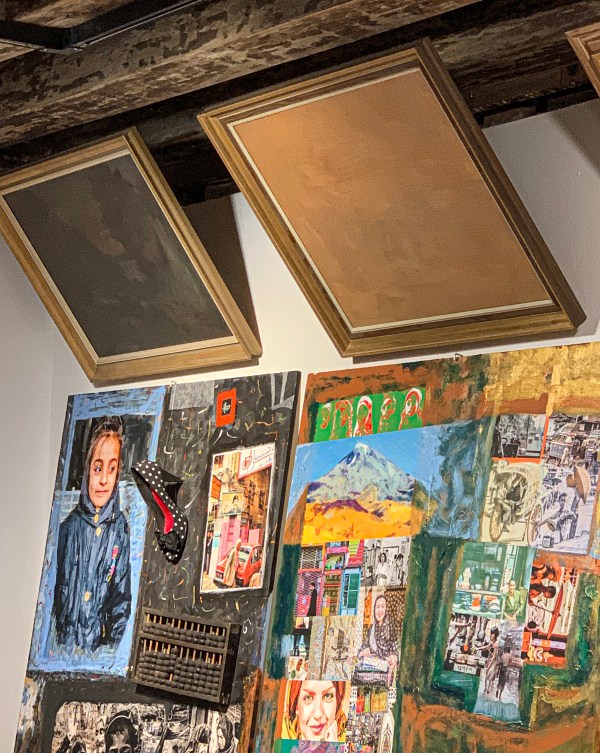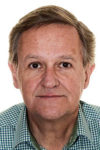The Venice Future Dialogues
TRANSCEND MEMBERS, 4 Nov 2019
Jan Oberg | Oberg Photo Graphics – TRANSCEND Media Service
26 Oct 2019 – How the Silk Peace Art Road installation stimulates dialogues about the world and what a couple of thousand people from all over that world shared with me… This article is a report of what visitors to my installation in Venice have shared with me about the world, what they fear and hope. If you are not interested in a few preliminary thoughts on the validity of my observations, in who they were and how I dialogued with them, you may jump straight down to “What people told me about the world” and read from there to the end.
If an art work – in and of itself – makes people happy or angry or otherwise cause an emotional reaction, it probably has some qualities. If it leaves you indifferent and you think ‘and so what?’ – it may lack that quality to touch you more deeply.
If an art work speaks to you in that sense but also makes you reflect on things beyond that art work and yourself, perhaps about a social problem or some vision, then on can talk about an added value – a beyond-itself quality or larger, more general, human/political quality.
Without, I hope, undue self-praise, it seems that my Silk Peace Art Road – SPAR – installation at Palazzo Mora as part of the 2019 Venice Biennale has that beyond quality.
I’ve had the great joy to talk with a lot of people from around the world – 40-60 per day, I guess – from around the world in front of it.
When I explain to people that SPAR is about the past and the – possible – future, about war and peace and about the West/Occident and the East/Orient – and goes from lighter to darker colours – virtually everyone opens up and shares their views, their fears, and their hopes.
When they do, I have often asked them where they are from and what they do in life – and they gladly share that too with me.
It’s not like at an academic seminar, or a panel discussion. It’s individuals, couples, perhaps a family or a group of students circulating in and out of the room. It’s an extended dialogue with me as the only constant factor, interviewer and dialogue-partner.
The meetings are spontaneous and surprising, they may last from a few minutes to, say, half an hour and end with shaking hands, exchanging business cards, emails, social media presence, etc. In some cases even a hug – in 100% of the cases a ‘thank you so much’ and wishing each other well.
I call these spontaneous encounters my Venice Future Dialogues or SPAR Dialogues in Venice.
Not representative of humanity but still…
Of course, what I learn from these very human encounters is by no means representative for this or that nation, region or for humanity asa whole.
People who come to Venice for the formal, national-pavilion Biennale and the other art exhibitions all over town – 229 in total! – are of course related to contemporary art in all its manifestations; they may be artists themselves – professionals or amateurs – young people studying art history or attending an art academy – or simply people who love art, go to exhibitions, perhaps are themselves collectors.
No, they are not representative, do not represent a kind of average citizens of the world. Far from it.
Those whom I have come into contact with are, in very many cases, rather independent-and broad-minded, are engineers, social workers, teachers, architects, business people, either small businesses or people who have traveled as employees of, say, a multinational corporation and have seen quite a bit of the world. But I’ve also talked with carpenters and nurses and people who have tried lots of jobs to make a living while doing something creative that yields no money.
They are generally curious, they care about other human beings and about the world beyond the average.
Common is also that they belong to more countries – like, say, a Chinese artist living in Germany; a Dane who has founded a movie company in London, an American who has spent all her vacations traveling through Central Asia to learn because she doesn’t, generally, trust what her media tell her. I also noted that a lot of couples no longer are from the same nation but have met somewhere – another aspect of globalization…
Some are old, pensioners, have started up a second “career”; others have been in their early 20s and just begun a career or some studies, or work to earn enough to study.
It’s people who create their own lives rather than follow a career pattern.
Naturally, many have been Italian – or foreigners living in Italy – but the Venice Biennale is a manifestly global art event that attracts people from all corners of the world – no, not equally much, there is a Western “Schwerpunkt” or bias/dominance.
But I have indeed met so many non-Westerners too.
And how many did I talk to? Three weeks in May 2019, one week in October and 5 days at the end in November makes 35 days. 6-8 hours a day – 40-60 people – well, it makes somewhere between 1400 and 2100 people.
A lovely encounter! Liya Hua – from Shanghai and Hawaii and her parents:
httpv://vimeo.com/369062846
Also not a scientific investigation
Before I plunge into it, let me tell you, dear reader, that I am a PhD in sociology (1981 at Lund University in Sweden) and I have spent my academic professional life being a peace, conflict and future researcher.
I’ve been a visiting professor of peace studies in several countries and cultures; I have conducted conflict analyses in a series of conflict and war zones, been a mediator, consultant to conflicting parties (always unpaid, I should add) and taught non-violent conflict resolution and reconciliation among conflicting parties.
This is to say that I have a certain training in talking with people of many walks of life, connecting fairly easily with most – indeed not with all, some are too closed to open up during a short encounter, or hesitate to share their opinions or who they are. But most people are eager to share and dialogue – tell their story…
So, I am used to “get something out of it” in relatively short meetings. And, that said, I have not at all employed any sociological methods of a survey type of even thought of how I interacted with those who came into the room where SPAR is installed. I haven’t taken notes or jotted down – there was no time because people circulated in and out of the room rather constantly.
And the dialogues were not comparable, I did not ask the same questions to compare answers etc. Each was spontaneous, took us in that direction, or this.
We spoke as humans-to-humans – no more, no less.
What people told me about the world…
What follows are main themes from my dialogues with visitors there in Palazzo Mora, 2nd floor, room 216 – where, by the way, Yoko Ono had her installation in 2017.
Based on talking with, as I said, perhaps 2000 people from around the world, the majority people from Italy and the other West but at least 1/3 from the rest of the world.
They are not listed by any criteria – like how many people expressed an opinion, its frequency or intensity. It’s simply themes that came up repeatedly – enough times to make me remember them and reflect on them.
- There is a deep concern of where the world is heading. A very serious sense of multi-crisis with ‘climate change’, economic decline, warfare and lack of sense of democracy are words that come up again and again.
- An equally deep sense that, even though I would want to, I do not know where or how I can contribute to combat these problems – feeling powerless, of there being no one who really listens to the people.
- When asked about positive developments they see, people say I do not really know – but I hope. Many left my room with – “well, Jan, let’s hope for the best…!”
- A very low level of confidence in the mainstream media’s reporting about the world – but many anyhow had views reflecting the official narrative, say about Russia/Putin or why there is a war in Syria.
- Everyone hates war. They believe it does not good and cost huge sums that should be used for something else.
- The United States is dangerous and its democracy is falling apart. The self-isolation of the country from the rest of the world is bad.
- President Trump is characterized in exclusively negative terms like “a fool”, dangerous, psychopath, stupid…
- The focus is on Trump more than on the system as such, the deep state or the military-industrial complex. A bit like – after him everything will hopefully be better. But there was also another frequent attitude expressed – namely that the system is thoroughly rotten and beyond repair (both Americans and non-Americans).
- With all these wars and bullying, the United States cannot continue to be a world leader.
- Virtually all Americans I talked with shook their head, almost apologized for their country’s behaviour, President and image.
- Opinions about China differs makedly according to whether people have visited the country or not. Among Westerners who had been to China, worked there or just visited, there was a much more positive image than among those who had not and therefore relied on media images of China.
- Most Westerners had either never heard about the belt and Road Initiative (BRI) or had a very vague sense of what it is – asked me to tell them, or read the information on my explanatory wall. With no exception, they were amazed that they had seen nothing about it in their media. They had also notheard that China celebrated its 70th Anniversary as Republic on October 1, 2019.
- A very mixed view about China. Many had the view that China’s development and the uplifting of hundreds of millions out of poverty of course was impressive and a good thing for the world but that – still – it is a dictatorship, violates human rights (the Muslim minority in particular and Tibet), will likely try to dominate the rest of the world and is a major culprit when it comes to militarism/being a threat and to pollution and overall climate change.
- Some who had been to Tibet, refused to ever visit other parts of China.
- A small majority, I believe, have negative views of Muslims, particularly Europeans who have not been to the Middle East. There were basically two attitudes: a) we in Europe ought to be more generous when people seek asylum – also because they have run away from destruction that Western countries/NATO have caused in their country; and b) Muslims (including refugees) don’t belong to Europe, they are “invading” us and threaten our European identity.
- People admire people who work for peace. Everyone I talked to responded positively when I told them that, as a scholar, I worked for the UN Charter norm that ‘peace shall be established by peaceful means’ and that Gandhi was an important inspiration in my life. Some, however, also saying that that of course was nice, but perhaps too idealistic in this world.
- As for Russia, most Western Europeans I spoke with had a negative attitude to the country and to President Putin in particular. Those who had, invariably reacted with considerable surprise when I told them that it is one country with 8% of the military expenditures their 29 adversary countries in NATO have combined. “I never heard that…”
- Quite mind-boggling to me – virtually no one, no matter from where, had much good to say about democracy. Many expressed that they thought it had become a joke – like “well, of course I vote but I have long ago stopped believing that politicians do something because we, citizens, vote for it. It’s become a dirty game, a power play – and, no, I wouldn’t dream of joining politics myself…”
- Concomitant with that, a large majority saw authoritarianism rising virtually everywhere. Leaders of the US, Britain, France in the Western world, were mentioned – but of course also Orban (by people from Hungary), of course Putin and Xi Jinping. People from around the world’s other countries found their own leaders not trustworthy, wealth accumulators and power players – I can’t remember anyone who said something to the effect that “our president/prime minister is a really good man, a woman/man of the people and I am confident that everything will be better in the future…”
- There is a general sense that the world has increasingly become a lawless place and that people and countries get away with unlawful behaviour. A clear regret that the United Nations don’t play much of a role anywhere and that norm of the past, some kind of decency and moderation has been thrown overboard.
- If memory doesn’t fail me, not one mentioned terrorism or said that they feared being the object of a terrorist attack where they live.
“May you live in interesting times…” and the ‘paibians’
The theme of this year’s Venice Biennale is “May you live in interesting times” – which is a kind of ironic curse/wish stated by a British diplomat rather than a Chinese slogan as has often been stated.
According to that source, Joseph Chamberlain may have come close to this formulation when, in a speech in 1898, he said:
“I think that you will all agree that we are living in most interesting times. (Hear, hear.) I never remember myself a time in which our history was so full, in which day by day brought us new objects of interest, and, let me say also, new objects for anxiety. (Hear, hear.)
The dialogue themes above reveal, in my view, very clearly that we are indeed living in interesting times. And since my installation is also about China and the Belt and Road Initiative (BRI) and the change of the world order – it’s worth pointing our, albeit in passing and in relation to the “interesting times,” that:
“The Chinese word for “crisis“ (simplified Chinese: 危机; traditional Chinese: 危機; pinyin: wēijī) is frequently invoked in Western motivational speaking as being composed of two Chinese characters signifying “danger” and “opportunity” respectively. (See Wikipedia).
The often quite gloomy views that my fellow interlocutors expressed may be interpreted as just doom and gloom – but it could also be that they should be perceived as a dawning, a new consciousness that there is a future for humanity that may be better – a vision – but that we do not know, yet, how to get there.
Because it is a great step in the right direction that people are indeed conscious of there being something seriously wrong. Without such a sense, such an intuition, there can be no meaningful dialogue about change, about a better world out there.
The contours of that future are vague. They have to be. We do not know the future the way we know the past and the present. But it is when we have a clearly defined problem that we can begin to discuss: What do we do now? How do we get out of this calamity? Where do we want to go.
This way of thinking is imbedded in my installation too.
On top of it, you see two of the four framed paintings leaning outwards as if looking down upon the visitor. They are inspired by the Chinese ‘paibians’ – those often big pieces of wood (oak) that lean out over doors to temples, shops or homes. On them are carved or painted some calligraphy stating peace or harmony or welcome.
I could not afford to buy such paibians for my installation. So I bought these four in a flee market, checked that none of them was a Picasso or similar 🙂 and then painted them over with iridescent white acrylic paint. That gives a half-glossy surface with a slightly mirror-like effect. They change when you move in front of them, depending on the light source – somewhat like mother of pearl.
And, importantly, that paint makes the original motive disappear to a certain extent, kind of blur it. And that is exactly why I chose this solution: To discuss the future, we have to look up from our everyday lives and see a larger perspective. We have to envisage some kind(s) of future(s) to begin walking in a new direction. What we can’t envision, we won’t pursue. And it is dim, unclear, vague – blurred. And it does reflect ourselves – and we must be able to see ourselves somewhere in that vision of the future.
It could be this – it could be that – but it is light and dark, as life itself can be.
After all, SPAR is about the world you are going to live in so thanks for coming around!
httpv://vimeo.com/369008602
Oh yes – we did talk about SPAR as an art work
You may think that we only had “political” discussions in front of SPAR. That’s not so. People asked me many questions about the techniques, the artefacts, why I had chosen to present photos in this “painted-in” way, how it was to print photos on canvas, why each of the four panels rested on podiums and how I got the idea to create the installation in the first place – and: “What’s the stooooory…”
And virtually all were impressed when I told them that as an artist I am self-taught whereas I have spent my life in peace research and teaching and by being on-the-ground in conflict zones.
As a scholar, I am aware that people generally do not read thick books about world affairs. And that we live in an era in which images of all possible kinds dominate.
Indeed, people are more informed than 20-40 years ago. But they have less knowledge – if we define knowledge as systematised, or categorised, information. Knowledge is about connecting the information/data dots meaningfully into cohesive structures of understanding.
And understanding the world is indeed a complex thing. If art can help us articulate concerns, fears, hopes and vision – so much the better.
– so here is that stoooooory…:
httpv://vimeo.com/369049596
Putting the SPAR Installation on the new Silk Roads… from Venice to China
I am very very happy that it is now proven, beyond doubt, that the SPAR installation has this “beyond-itself” character and can SPARk off dialogues about our future on this Earth.
That has convinced me about the potentials of the next stage of this project: That SPAR shall be shown in capitals in the Belt and Road countries and/or those that are represented in the installation’s images. If shown at galleries, museums, art spaces etc. there, it can make a small but important contribution to inter-cultural dialogue.
Perhaps you, dear reader, know people and art institutions in Belgrade, Athens, Istanbul, Damascus, Moscow, Tblisi, Yerevan, Baku, Tehran, Ashgabat, Tashkent, Astana, Dushanbe, Bishtek, Islamabad and the around China, perhaps starting out in Xian which is the old capital and starting point of the old Silk Road?
If so, please read the SPAR Exhibition Partnership Program and contact me.
__________________________________________
TFF Director Prof. Jan Oberg is a member of the TRANSCEND Network for Peace Development Environment.
Go to Original – obergphotographics.com
Tags: Art
DISCLAIMER: The statements, views and opinions expressed in pieces republished here are solely those of the authors and do not necessarily represent those of TMS. In accordance with title 17 U.S.C. section 107, this material is distributed without profit to those who have expressed a prior interest in receiving the included information for research and educational purposes. TMS has no affiliation whatsoever with the originator of this article nor is TMS endorsed or sponsored by the originator. “GO TO ORIGINAL” links are provided as a convenience to our readers and allow for verification of authenticity. However, as originating pages are often updated by their originating host sites, the versions posted may not match the versions our readers view when clicking the “GO TO ORIGINAL” links. This site contains copyrighted material the use of which has not always been specifically authorized by the copyright owner. We are making such material available in our efforts to advance understanding of environmental, political, human rights, economic, democracy, scientific, and social justice issues, etc. We believe this constitutes a ‘fair use’ of any such copyrighted material as provided for in section 107 of the US Copyright Law. In accordance with Title 17 U.S.C. Section 107, the material on this site is distributed without profit to those who have expressed a prior interest in receiving the included information for research and educational purposes. For more information go to: http://www.law.cornell.edu/uscode/17/107.shtml. If you wish to use copyrighted material from this site for purposes of your own that go beyond ‘fair use’, you must obtain permission from the copyright owner.
